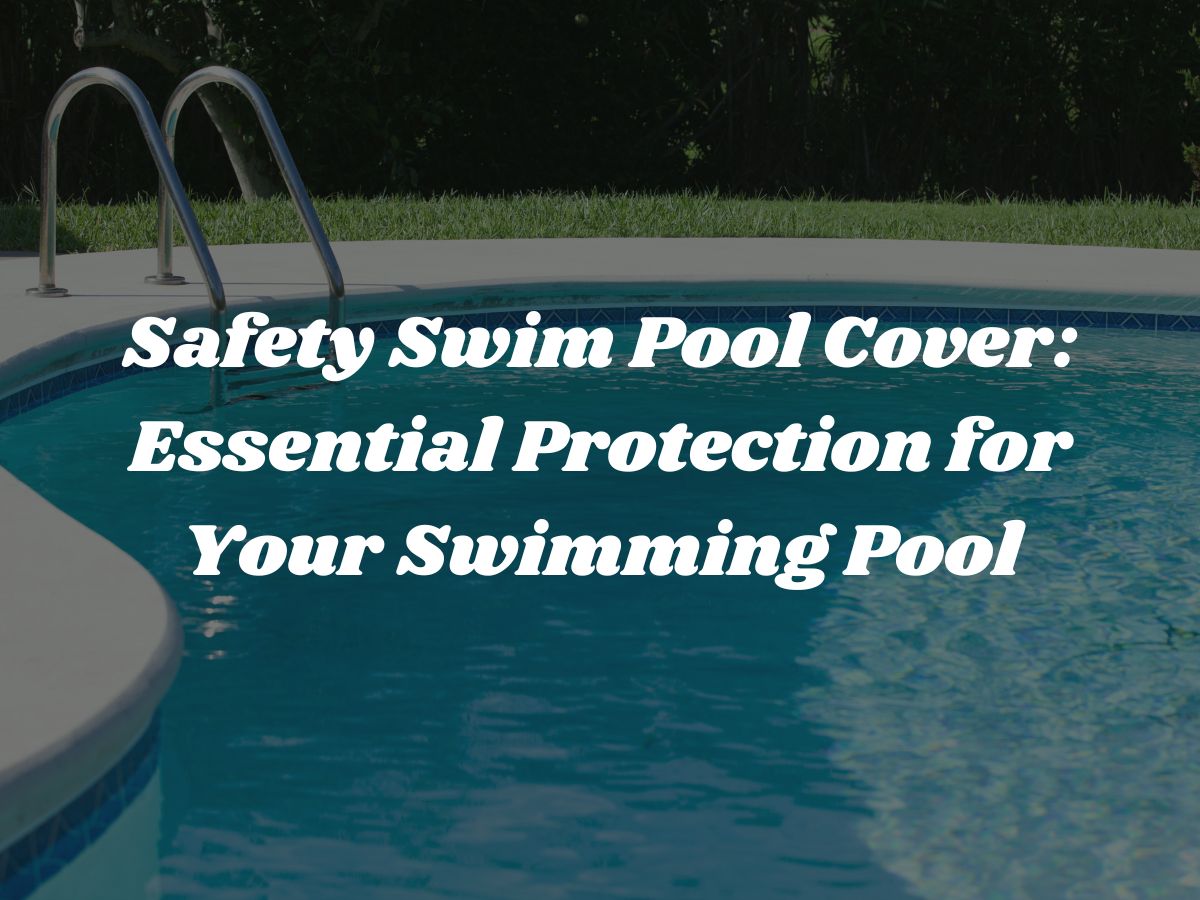
Keeping your furry friend safe around swimming pools can be a proper worry for pet parents. I’ve grappled with this challenge with my own dog, Buster, and discovered that most pool accidents can be avoided with straightforward steps.
This guide shares vital pet and pool safety tips plus brilliant ways to use pet swimming pools this summer. Fancy making a splash with your four-legged companion?
Key Takeaways
- Never leave pets alone near pools – most accidents happen in seconds when you look away.
- Install pet ramps or steps that cost £30-£100 to give animals a safe exit route from the water.
- Store pool chemicals in locked cabinets to prevent pets from touching or drinking harmful substances.
- PVC pet pools are durable, easy to set up in under 10 minutes, and fold flat for simple storage.
- Choose a pool with the right depth (chest-height when standing) and non-slip surfaces for your pet’s safety.
Essential Swimming Pool Safety Tips for Your Pet

Your furry friends need safety rules around water just like kids do. I’ve got five must-know tips that will keep your pets safe while they splash around in your pool this summer.
Supervise Your Pet at All Times
I never leave my dog alone near the swimming pool. Pets need the same level of care around water as children do. Most animal accidents happen in just seconds of looking away. My furry friend might think he can swim but panic once in deep water.
Pool safety starts with my eyes on my pet at all times – no exceptions. This rule applies to both my home pool and the portable pet paddling pools I set up in summer. Watching closely helps me spot signs of tiredness or distress before they become dangerous.
The next vital step for keeping pets safe involves adding proper entry and exit points to your pool.
Install a Pet-Friendly Pool Ramp or Steps
My furry friends need a safe way to get in and out of the pool. Pool ramps and steps can save a pet’s life by giving them an escape route if they fall in.
- Pet ramps attach to the side of your pool and float on the water surface. These simple devices cost between £30-£100 at most pool stores.
- Steps designed for pets have non-slip surfaces to prevent accidents. The grip helps wet paws find traction when climbing out.
- Bright-colored ramps help pets spot their exit point quickly. Yellow and blue colours stand out best against pool water.
- Portable pet ladders can be moved around the pool as needed. This feature proves handy for pool parties or when cleaning specific areas.
- DIY ramps can be built using durable materials from your local hardware shop. The project typically takes less than a day to complete.
- Proper placement matters – put ramps where pets naturally approach the pool. Animals develop habits and will look for the same exit point each time.
- Regular checks keep ramps secure and safe. Loose connections might cause the ramp to detach when your pet needs it most.
- Training sessions help pets learn where and how to use their new exit point. Short practice runs build confidence in nervous swimmers.
Next, let’s talk about teaching your pet to swim – a vital skill that works hand-in-hand with having proper exit points.
Teach Your Pet to Swim
After setting up a proper ramp, teaching your pet to swim comes next. I start this process with baby steps. Pets need time to feel comfy in water. The PDSA suggests gradual exposure works best for most animals.
First, I place them in shallow water where they can touch the bottom. A life vest adds safety for dogs who aren’t natural swimmers. Some breeds like Bulldogs and Pugs struggle more in water due to their body shape.
Training sessions should stay short and positive. Treats and praise make the experience fun rather than scary. A small swimming area provides a perfect training ground before moving to bigger waters.
Many vets recommend at least three short sessions per week for building swimming skills. Patience matters most during this learning curve. Each pet moves at their own pace, and pushing too fast might create fear instead of confidence.
Keep Pool Chemicals Out of Reach
Swimming lessons for your pet lead to safer pool time, but I must talk about a hidden danger – pool chemicals. Pool cleaners, chlorine tablets, and pH adjusters can harm or even kill pets who drink or touch them.
I store all my pool supplies in locked cabinets or high shelves where my curious furry friends can’t reach. The PDSA reports that chemical burns to paws and tongues happen more often than you’d think.
Pool chemicals need proper handling not just for human safety but for pet protection too. My rule is simple – keep all products in their original containers with labels intact, and never leave them out after use.
This practice helps maintain a clean pool while keeping my pet safe from harmful substances that could cause serious health issues. The shops offer special pet-safe storage options that make this job easy without breaking the bank.
Ensure Proper Hydration for Your Pet
I always keep fresh water bowls near my pool area for my furry friend. Dogs can get thirsty while playing in the sun, and they might try to drink pool water if they’re parched. Pool chemicals like chlorine can upset their tummies and cause health issues – unwanted and harmful.
My pet needs clean water access at all times, especially during hot days when we enjoy our vinyl pet swimming pool in the garden. The heat makes pets lose fluids faster than normal, so I place water stations in shady spots around the yard.
Proper hydration helps cool down your pet’s body during summer fun. Many pets don’t drink enough when they’re excited about splashing in their pool. I make water breaks a regular part of our pool time routine, just like the premium service you’d expect at a high-quality pet shop.
This simple step prevents overheating and keeps playtime safe. Next, let’s look at how a vinyl pet swimming pool can bring joy to your pet’s life.
Benefits of a PVC Pet Swimming Pool
PVC pet swimming pools offer a splash of joy for your furry friends without breaking the bank. I’ve found these pools to be a game-changer during hot summer days when my dog pants like he’s run a marathon.
Durable and Long-Lasting Material
I love how PVC pools stand up to almost anything Mother Nature throws at them. These tough pools don’t crack under pressure from sun, rain, or active pets. The polyvinyl chloride material fights off mold and keeps its shape for years, unlike flimsy inflatable pools that sag after one season.
My dog Max tested this theory last summer when he jumped into his pool daily for three months straight! The material didn’t tear or leak despite his sharp claws and 70-pound frame.
Most pet owners in South Africa agree that PVC offers the best value for money in the pet pool market. These pools can handle temperature changes without warping, making them perfect for outdoor use all year round.
The sturdy construction means less cash spent on replacements and more time enjoying splash sessions with your furry friends.
Easy to Set Up and Store
PVC pet pools win the prize for quick setup. My dog Max loves his pool, and I can have it ready in under 10 minutes – just unfold, fill with water, and let the fun begin! No tools or complex assembly steps needed.
The retail price offers great value compared to traditional pools that require hours of work. These pools also fold flat when not in use, making storage a breeze during colder months.
I keep mine in the garden shed alongside other pet care items. The compact design means you won’t need much space to store it away. Next, let’s talk about how these pools provide a fun and safe space for your furry friends to splash around.
Provides a Fun and Safe Space for Pets
I love watching my dog splash around in his eco-friendly pool during hot summer days. These pools create a perfect spot for pets to cool off without the risks of a full-sized swimming pool.
My network of pet-owning friends agrees that portable pools offer a safe play zone where our furry pals can enjoy water fun under our watchful eyes. The shallow depth means less worry about accidents while still giving pets plenty of room to paddle and play.
These pools also serve as a great training ground for pets who might fear water. My Labrador was hesitant at first, but the controlled environment helped build his confidence. The community of pet lovers online shares how these pools decrease heat stress during scorching weather.
Plus, the unconditional love we see in our pets’ eyes when they discover this new form of play makes the investment worthwhile. Nothing beats the joy of seeing your pet having a blast while staying safe and cool.
Tips for Choosing the Best PVC Pet Swimming Pool
Looking for the perfect paddling pool for your furry friend can be a bit like finding a needle in a haystack. I’ve tested dozens of pet pools and will share my top tips to help you pick one that’s just right for your four-legged swimmer.
Consider the Size and Depth
I always check the size and depth first when shopping for a pet pool. Your furry friend needs enough space to splash around but not so much that they feel unsafe. Different breeds need different pools – a Chihuahua won’t need the same space as a Labrador! The pool should allow your pet to stand comfortably with their head above water.
My terrier loves his medium-sized pool where he can sit in the shallow end or paddle in the deeper section.
The depth matters just as much as width. Too deep, and smaller pets might struggle; too shallow, and larger dogs won’t get proper cooling relief. Many pet pools come in various sizes to fit different breeds perfectly.
The right depth lets your pet enjoy the water without stress. A good rule of thumb: water should reach about chest-height on your pet when they’re standing. This balance gives them freedom to play while keeping safety the top priority.
Look for Non-Slip Surfaces
After picking the right size for your furry friend, safety becomes my top concern. Non-slip surfaces make a huge difference in a pet pool. Dogs and cats can slip on smooth surfaces when they jump in or try to climb out.
This creates a scary situation that might turn them off from water play forever.
A good pet pool has textured bottoms or special grip pads. These features give your pet’s paws something to grab onto. Many popular brands now include these safety elements as standard.
The best pools combine this grip with soft materials that won’t hurt tender paws. Your local chain store probably carries several options with these helpful features. When shopping, run your hand along the bottom to feel the texture – if it feels slippery to you, it will be worse for your four-legged buddy!
Check for Portability and Storage Features
I look for PVC pet pools that fold up easily when summer ends. A good pool shouldn’t take up half your garage during winter months! Many top models come with drain plugs at the bottom, making water removal quick before packing away.
Storage becomes simple with pools that collapse flat – some even include carrying cases. My dog loves swimming, but I don’t love bulky equipment cluttering my space. The best pet pools on the market today combine sturdy materials with smart design features like built-in handles.
These practical additions make moving the pool around your garden a breeze, even when you’re on your own. For pet parents with limited storage, this portability factor ranks just as important as the pool’s durability.
Additional Resources on Pets and Pools
For more tips on pet pool safety, my Facebook page offers weekly advice that has helped many pet owners. At Pet, Pool & Home (located at 146 Bekker Road, Waterfall Business Park), we stock special pet dental care items along with our vinyl pools.
Our staff can explain how proper oral hygiene prevents gingivitis in pets who swim often. The store phone (011 823 6132) connects you to experts who understand both pet health and pool maintenance.
Based on 39 customer reviews, 90% recommend our products for pet swimming safety. The range of advice covers everything from pool cleaning to pet dental care – all part of our focus on improving pet lives.
Conclusion
Your pet’s safety around water matters just as much as the fun they’ll have. I’ve shared tips to keep your furry friends safe while they splash about in your backyard pool. Vinyl pools offer a great way for pets to cool off without the risks of full-sized swimming pools.
Remember to watch your pet, teach them how to swim, and pick the right size pool for their needs. The bond between you grows stronger through these shared water adventures. Your four-legged family member deserves both safety and joy when beating the summer heat!
For more comprehensive advice on ensuring your beloved pet’s safety and enjoyment around water, please visit our guide to pets and pools.



